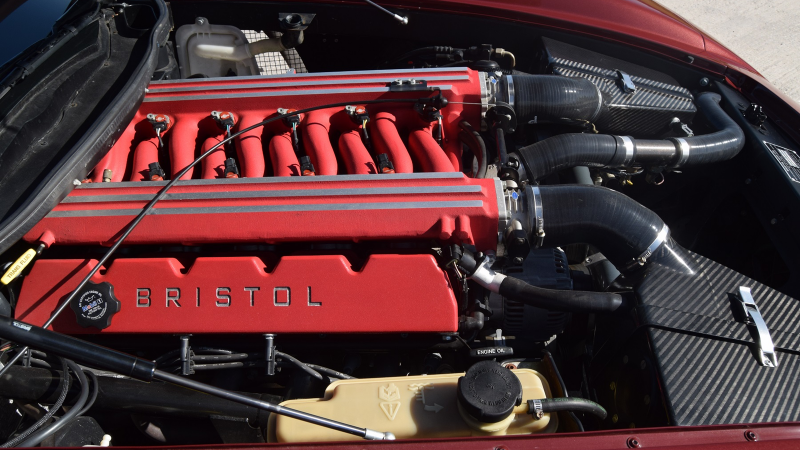














Martin Buckley takes a drive in a rare beast
I hate supercars. Partly because they’re too big and usually very ugly, but mostly because they aren’t even rare any more.
Witnessing any real exotic as a kid in the ’70s meant having to go and have a lie-down to recover; today such vehicles are so plentiful that you don’t bother your neck muscles in turning to have a look.
Which only makes it rarer to find a supercar many people have never seen – and I don’t mean some shonky shed build cobbled together from eBay parts and heartache.
Take the Bristol Fighter: this beautiful, understated and under-appreciated vehicle is undoubtedly a supercar, but it's a quite different beast from the usual mid-engined brigade.
A mere 13 were built between 2004 and 2011, and the chances are it'll be the last of its kind. And that's a crying shame.
Flying start
Bristol Cars goes way, way back: born out of the Bristol Aeroplane Company, its first vehicle – the Bristol Monocar – arrived in 1918 as the product of a workforce suddenly unoccupied.
Some three decades later, BAC was taken over and an automotive department was opened, with a factory near – where else? – Bristol.
Limited luxury
From the off, Bristol was all about low numbers and hand-built luxury.
From the BMW-derived 400 (pictured left) to the streamlined 603, quality was in Bristol’s DNA – a fact reinforced by the location of its one and only showroom: Kensington High Street, London. And 2004’s Fighter (pictured right) was no exception.
Proper performance
Powered by an 8-litre V10 Viper engine, it can’t be argued that this 200mph two-seater was anything other than a supercar – but it was also a practical one, built to appeal not only to established Bristol owners but a generation of buyers who, even in 2004, were alienated by the excesses of the usual mid-engined suspects.
Rare opportunity
It must have been 2004 when I last drove one, accompanied by its understandably apprehensive new owner on a rainy day in Sussex.
All I can recall about the encounter was that one of the windscreen wipers made a successful bid for freedom, and I don't think the car crossed my mind again – until I got a call from dealer Richard Hackett inviting me to drive a 2005 Fighter he has for sale, the one and only automatic with 3465 miles on the clock.
Better with age
Seeing it in the flesh, the coupé has more of a true Bristol look than I gave it credit for in 2004. Not beautiful, but distinctive and impressive in an understated way.
It’s also a sensible size, certainly shorter and narrower than its 200mph contemporaries – and with a drag coefficient of 0.28cd it’s about as slippery as it looks.
Mostly bespoke
Having climbed in through the gullwing door, I noticed that the handle for pulling it shut had disappeared. Some further gloss then evaporated when I saw the ignition key had LEXUS written on it.
Yet there are few other borrowed bits in a cabin that’s mostly bespoke and well-planned – and that you can actually see out of while sitting comfortably.
Flighty stuff
Hand-turned alloy switches in the roof and an 'Engine Hours' indicator give an appealing aeronautical flavour befitting Bristol’s heritage, without ramming it down your throat.
The poverty plastic eyeball vents, on the other hand, hark back to the marque’s early days of trawling the parts bins of other manufacturers.
Practical and fast
Externally, it benefits from proper ground clearance so the traffic calming lumps that befuddle your average McLaren hold no fears for the Fighter.
Neither do the increasingly pot-holed main roads over which it strides with graceful firmness and long legs, giving 70mph at 1500rpm.
No slacking
Under the bonnet, the V10 engine is 'dressed' with handsome Bristol covers – and the huge performance makes light work of every incline and overtaking scenario, with epic pull in each gear.
The only downside? Its noises are 'commercial' rather than exotic. Then again, making stirring sounds just for the sake of it would not be the Bristol way.
Thrilling combination
This thing is grown up and surprisingly sorted for a car only built to the tune of 13 examples. It’s a combination of the litheness of the great 2-litre Bristols of the ‘40s and ‘50s – in its steering and agility – and the effortless thrust of the Chrysler V8s.
All the right ingredients
Here, then, is a capable, powerful and practical supercar, with all the quirks a true pedigree of the breed should have, without needless ostentation – except, perhaps, the garnish of those gullwing doors. And every supercar needs those.
Last of its kind
It’s a credit to former Bristol Cars boss Toby Silverton that it ever happened at all – and that the ex-Chairman made sure the Fighter was as good as it was, even if it does look like it will be the last of its kind.
Dying breed
Sadly, Fighter production ceased at the same time as Bristol went into administration in 2011.
While the marque was bought and reborn, refurbishing and selling existing models, there remain question marks over whether a new Bristol will again see the light of day.
Lesser-spotted forever
If a new Bristol Fighter could be sold for less money and marketed in a way that took account of 21st-century attention spans, there might still be a place for it as a true supercar upstart.
If not, those original 13 are likely to remain the only examples you’ll probably never see.
This 2005 Bristol Fighter is available from SLJ Hackett, priced £195,000. Click here for details
